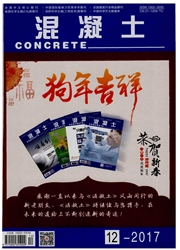

 中文摘要:
中文摘要:
沿海、盐碱地电厂等混凝土建、构筑物受盐害作用,导致其使用寿命降低。故引入对三乙烯四胺双向电渗短期效果的研究。对混凝土试块进行恒流通电,采用通电时间t=15d,通电电流密度1=3A/m^2,研究不同水胶比、初始氯离子含量、保护层厚度作用下,三乙烯四胺阻锈剂在混凝土试块中的双向电渗效果。结果表明,混凝土试块中氯离子排出量和水胶比、初始氯离子含量成递增关系,和保护层厚度成递减关系;三乙烯四胺阻锈剂迁入量和水胶比成递增关系,和初始氯离子含量关系不明显,和保护层厚度成递减关系。同时,通电后测量,钢筋的腐蚀电势以及钢筋/溶液界面电荷转移电阻均有不同程度增大,但其腐蚀电流也有一定程度增大。
 英文摘要:
英文摘要:
In coastal and saline alkali area,power plants and other concrete structures are subjected to salinization, resulting in decrease of service life.Therefore,it introduces a short-term experimental study of material properties for bilateral electro-osmotic method with triethylenetetramine inhibitor.The concrete block is tested with galvanostatic method,while the power on time t=15 d and the electric current density I=3 A/m^2.With different water cement ratio,the initial chloride ion content and protective layer thickness,it study the bilateral electro-osmotic effect of triethylenetetramine (TETA) inhibitor in the concrete block.The results show that chloride ion excretion in concrete block increased with water cement ratio and the initial chloride ion content, which decreased with protective layer thickness. And the immigration amount of TETA inhibitor increased with water cement ratio, and decreased with protective layer thickness, which shows no obvious relationship with the initial chloride ion content.At the same time, the corrosion potential of the steel and the charge transfer resistance of the steel/solution interface increased after the electric power, but the corrosion current increased to some extent.
 同期刊论文项目
同期刊论文项目
 同项目期刊论文
同项目期刊论文
 期刊信息
期刊信息
